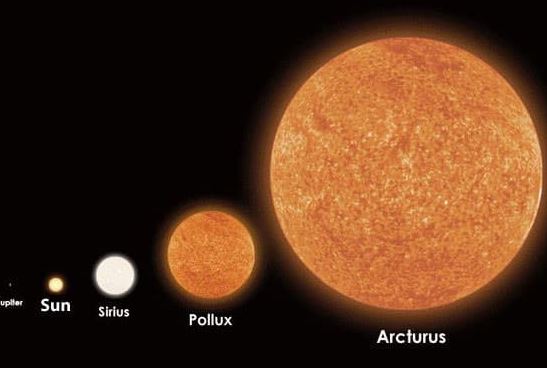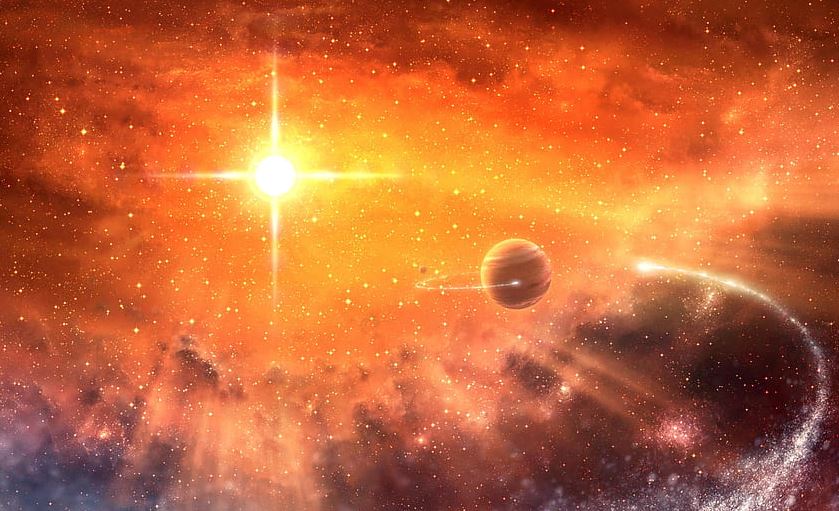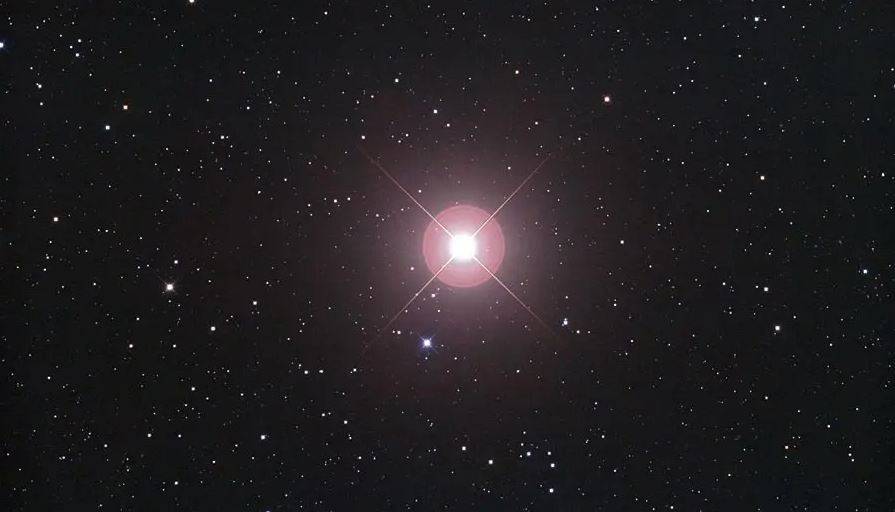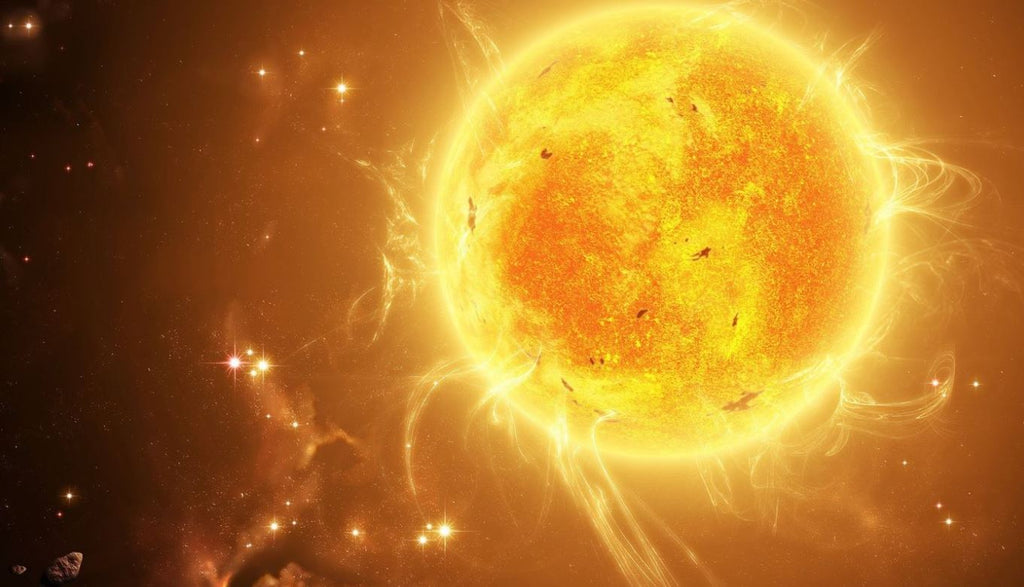Arcturus Star
Uncover the secrets of Arcturus, the fourth brightest star in our night sky, in this comprehensive blog post. Learn about its unique characteristics, history, mythology, and influence on human culture throughout time.
Arcturus, a brilliant gem in the night sky, has captivated stargazers and astronomers for centuries. As the fourth brightest star visible from Earth, Arcturus has played a significant role in human culture, history, and mythology. In this comprehensive blog post, we'll explore the fascinating characteristics of Arcturus, delving into its unique features, its place in the constellation of Boötes, and its influence on various cultures and mythologies throughout time. Join us as we uncover the secrets of this celestial marvel.
Arcturus Star Spectral Type
Arcturus is classified as a red giant star, and its spectral type is K1.5 III. This spectral type indicates that it is a relatively cool giant star with a reddish hue.
How Old is The Star Arcturus
Arcturus is estimated to be around 7 to 8 billion years old. It is considered an older star than our Sun, which is approximately 4.6 billion years old. Arcturus's age places it in the later stages of its evolution.
Diameter of Arcturus Star
Arcturus is a giant star, and its diameter is notably larger than that of the Sun. It is estimated to have a diameter of around 26 times that of the Sun. As a giant star, Arcturus has expanded significantly in size compared to its earlier stages.
Arcturus Star Mass Compared to Sun
Arcturus is less massive than the Sun, with an estimated mass of around 1.1 times that of our solar system's star. Despite its lower mass, Arcturus has evolved into a giant star with different physical characteristics.
Arcturus Star Surface and Core Temperature
Being a red giant, Arcturus has a cooler surface temperature compared to the Sun. Its surface temperature is approximately 4,290 degrees Celsius (7,754 degrees Fahrenheit). The core temperature is much higher, reaching millions of degrees Celsius, where nuclear fusion reactions occur.
Arcturus Star Brightness Luminosity
Arcturus is a relatively bright star in our night sky. Its luminosity, or the amount of energy it radiates, is around 170 times that of the Sun. The increased luminosity is a consequence of Arcturus's expanded size as a red giant.
Arcturus Star Color
Arcturus appears distinctly orange-red in color. The red hue is a characteristic feature of cooler stars, and in the case of Arcturus, it is indicative of its status as a K-type giant star.
Arcturus Star Distance From Earth
Arcturus is located at a distance of approximately 36.7 light-years from Earth. It is one of the brightest stars visible from our planet and is easily observable in the night sky. Its proximity makes it a valuable object for observational studies and a familiar celestial feature for astronomers and stargazers alike.
Characteristics of Arcturus
- Type and Classification: Arcturus is a red giant star classified as a K0 III-type star. This classification indicates that Arcturus has exhausted the hydrogen fuel in its core and has expanded as it burns helium, giving it a distinct reddish-orange hue.
- Distance from Earth: Arcturus is approximately 36.7 light-years away from Earth, making it one of the closest stars visible to the naked eye.
- Luminosity and Temperature: Arcturus boasts a luminosity around 170 times that of the Sun, while its surface temperature is approximately 4,290 Kelvin (7,256°F or 4,016°C).
- Size: Arcturus has an estimated diameter of 25.4 solar diameters, meaning it is about 25 times larger than our Sun. If placed at the center of our solar system, Arcturus would extend beyond the orbit of Mercury.
- Mass and Age: Arcturus possesses a mass of approximately 1.1 solar masses, which indicates that it is slightly more massive than our Sun. The star is estimated to be around 7.1 billion years old, making it considerably older than our 4.6-billion-year-old Sun.
Arcturus Star compared to the Sun
This comparison table highlights some of the key differences between the Sun and Arcturus. While both stars share similarities, such as their classification as G and K-type stars, there are notable differences in their size, luminosity, temperature, and age. These differences reflect the distinct stages of stellar evolution that each star is currently undergoing, with the Sun being a main-sequence star and Arcturus being a red giant.
| Feature | Sun | Arcturus |
|---|---|---|
| Type | G-type Main Sequence (G2V) | K-type Red Giant (K0 III) |
| Distance from Earth | 1 Astronomical Unit (AU) | 36.7 Light-years |
| Luminosity | 1 Solar Luminosity (L☉) | 170 Solar Luminosities (L☉) |
| Temperature | 5,500 Kelvin (K) | 4,290 Kelvin (K) |
| Diameter | 1 Solar Diameter (D☉) | 25.4 Solar Diameters (D☉) |
| Mass | 1 Solar Mass (M☉) | 1.1 Solar Masses (M☉) |
| Age | 4.6 Billion Years | 7.1 Billion Years |
| Spectral Class | G2V | K0 III |
| Rotation Period | 25 days (equator) | Approx. 100 days |
| Color | Yellow-white | Reddish-orange |
| Apparent Magnitude | -26.74 (visible from Earth) | -0.04 (visible from Earth) |
| Absolute Magnitude | 4.83 | -0.30 |

Arcturus in the Constellation Boötes
Arcturus is the brightest star in the constellation Boötes, the Herdsman. Boötes is one of the 48 constellations listed by the ancient Greek astronomer Ptolemy and is now one of the 88 modern constellations recognized by the International Astronomical Union.
The constellation Boötes is relatively easy to locate in the night sky, thanks to Arcturus' exceptional brightness. To find Arcturus, simply follow the arc of the handle of the Big Dipper, a prominent asterism within the constellation Ursa Major. The phrase "arc to Arcturus" is a popular mnemonic to remember this method. Boötes is best observed during the months of April through June in the Northern Hemisphere.
Arcturus Throughout History and Mythology
The brilliance of Arcturus has made it a prominent feature in various cultures and mythologies throughout history:
- Ancient Greece: In Greek mythology, Boötes is often identified as the herdsman or plowman, who drives the bears (Ursa Major and Ursa Minor) around the celestial pole. Arcturus, as the brightest star in Boötes, is sometimes associated with the Herdsman himself or as his staff.
- Ancient Egypt: Arcturus was associated with the Egyptian god Osiris, the god of the afterlife. Its heliacal rising, or the first appearance of the star just before dawn, was used to predict the start of the Nile flood, a crucial event in the Egyptian agricultural calendar.
- Ancient China: Arcturus was known as Dajiao, the Great Horn, in ancient Chinese astronomy. It was one of the "Four Great Stars" and represented the celestial equivalent of the emperor in the Chinese cosmological system. The star's heliacal rising also marked the beginning of the spring season in the traditional Chinese calendar.
- Native American Cultures: Several Native American tribes, such as the Blackfoot and the Navajo, recognized Arcturus as an important star. The Blackfoot called it "Sikom", the Old Man, while the Navajo referred to it as "Atse Etsoh", the Big Star.
- Islamic Astronomy: In Islamic astronomy, Arcturus was known as "Al-Simak al-Ramih", the Lofty Lance Bearer. It was considered one of the four "royal stars" that marked the cardinal points of the celestial sphere and was associated with good fortune.
Arcturus in Literature and Popular Culture
Arcturus has made numerous appearances in literature and popular culture throughout time:
- The Bible: Arcturus is mentioned in the Book of Job (Job 9:9 and 38:32), where God speaks to Job about the wonders of the universe and asks if he can "guide Arcturus with his sons."
- Classical Literature: The Roman poet Virgil mentioned Arcturus in his epic poem the Aeneid, describing the star's role in guiding the hero Aeneas on his journey.
- Science Fiction: Arcturus has been featured in various science fiction works, such as Isaac Asimov's Foundation series, Robert A. Heinlein's Starman Jones, and H.P. Lovecraft's The Whisperer in Darkness.
- Music: The star has also inspired musical compositions, such as the English composer Gustav Holst's The Planets, where Arcturus is referenced in the movement titled "Mercury, the Winged Messenger."
Observing Arcturus
Arcturus is a popular target for both amateur and professional astronomers due to its brightness and relatively close proximity to Earth. While the star is easily visible to the naked eye, using binoculars or a telescope can provide a more detailed view of its reddish-orange color and its surroundings.
When observing Arcturus, you may also notice several fainter stars nearby, which are part of the constellation Boötes. These stars form an interesting backdrop for Arcturus and are worth exploring further with a telescope.
The Future of Arcturus
As a red giant, Arcturus is in the later stages of its stellar life cycle. Over the next few million years, the star will continue to burn helium in its core, eventually leading to its demise. As it exhausts its helium supply, Arcturus will expand even further, potentially becoming a highly luminous M-type red supergiant. At the end of this phase, the star's outer layers will be shed into space, forming a planetary nebula. The remaining core will then cool and contract, ultimately becoming a white dwarf. While Arcturus' transformation will take millions of years, understanding its future evolution gives us valuable insights into the life cycles of stars and the dynamic nature of our cosmos.
Arcturus in Astrology
In astrology, Arcturus is often associated with prosperity, wealth, and good fortune. As one of the four "royal stars" in ancient Persia, Arcturus was believed to bring protection, guidance, and balance. In modern astrology, the star is thought to provide inspiration, optimism, and a sense of purpose to those born under its influence. While astrology is not considered a science, its cultural and historical significance adds another layer of intrigue to the story of Arcturus.
Scientific Discoveries and Observations
Arcturus has been the subject of numerous scientific studies and observations, leading to various discoveries and a greater understanding of its nature. Some key findings include:
- Proper Motion: Arcturus has one of the highest proper motions among bright stars, meaning it moves relatively quickly across the celestial sphere. This rapid motion was first noted by English astronomer Edmond Halley in 1718 and is a result of Arcturus' proximity to our solar system and its unique trajectory through space.
- Radial Velocity: Arcturus was one of the first stars to have its radial velocity, or the speed at which it moves towards or away from Earth, measured using the Doppler effect. This pioneering work was conducted by American astronomer Vesto Slipher in the early 20th century and paved the way for future studies of stellar motion.
- Chemical Composition: Spectroscopic analyses of Arcturus have revealed that it has a slightly different chemical composition compared to our Sun, with lower amounts of heavier elements such as iron. This finding suggests that Arcturus may have originated in an older population of stars in the Milky Way, offering clues to the formation and evolution of our galaxy.
Arcturus vs Sun
Discover the intriguing differences between Arcturus and the Sun in this enlightening comparison. Arcturus, a red giant star located in the Boötes constellation, stands in stark contrast to our own Sun. While the Sun is a G-type main-sequence star, Arcturus has evolved into a red giant phase, expanding and radiating a reddish hue. In terms of size, Arcturus dwarfs the Sun, with a diameter nearly 25 times larger. Despite its luminosity, Arcturus falls short of the Sun's brilliance, emitting only about 170 times the Sun's energy. Explore the table below for an in-depth comparison of Arcturus and the Sun's key characteristics.
| Characteristic | Arcturus | Sun |
|---|---|---|
| Spectral Class | K0 III | G2 V |
| Diameter | ~25 times larger than the Sun | - |
| Luminosity | ~170 times that of the Sun | - |
| Temperature | Cooler than the Sun | - |
| Life Stage | Red giant phase | Main-sequence star |
| Constellation | Boötes | N/A |
Here's a comparison table highlighting the differences between Arcturus and the Sun:
| Aspect | Arcturus | Sun |
|---|---|---|
| Type | Orange giant star | G-type main-sequence star |
| Distance | Approximately 37 light-years away | About 93 million miles (1 Astronomical Unit) |
| Size | Considerably larger than the Sun | Diameter about 109 times that of Earth |
| Color | Orange-red hue | Yellow |
| Luminosity | Much more luminous than the Sun | Moderate luminosity |
| Mass | Higher mass compared to the Sun | About 333,000 times the Earth's mass |
| Temperature | Cooler surface temperature | Around 5,500 degrees Celsius (surface) |
| Evolutionary Stage | In the later stages of its life cycle | In the middle of its main-sequence phase |
| Spectral Class | K1.5 III | G2V |
| Stellar Activity | Variable brightness due to pulsations | Relatively stable and consistent |
| Impact on Universe | Contributes to heavy element production | Essential for sustaining life on Earth |
| Observational Impact | Offers insights into aging stars | Basis for solar studies and space weather |
The comparison between Arcturus and the Sun reveals the fascinating diversity within our cosmos. Arcturus, classified as a K0 III red giant, has progressed into the later stages of its life cycle, resulting in its expanded diameter and distinctive red hue. In contrast, the Sun, a G2 V main-sequence star, is currently in its stable phase, emitting a balanced stream of energy. Arcturus' greater luminosity is offset by its lower temperature, showcasing the intricate interplay between size, heat, and radiance. By understanding these celestial disparities, we gain a deeper appreciation for the vast array of stars that populate the night sky.
Conclusion
Arcturus, the fourth brightest star in the night sky, has captivated humanity for millennia with its stunning luminosity and unique characteristics. As we have explored in this comprehensive blog post, Arcturus has played a significant role in various cultures, mythologies, and historical events, inspiring countless works of literature, art, and music.

Whether you are an amateur stargazer or an experienced astronomer, observing Arcturus and its constellation Boötes is a rewarding experience that allows you to connect with the rich history and cultural significance of this celestial wonder. As you gaze upon Arcturus, remember that you are witnessing the light from a star that has traveled for over 36 years to reach your eyes, a humbling reminder of the vastness and beauty of the universe that surrounds us.
More Star Topics:
- How are stars formed?
- The life cycle of a star
- How many Stars are in the milky way
- Where is the north star
- 3 stars in a row in the sky
- What is an open star cluster
- What is a red giant star
- What is a white dwarf star
- What is a neutron star






